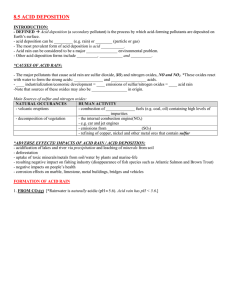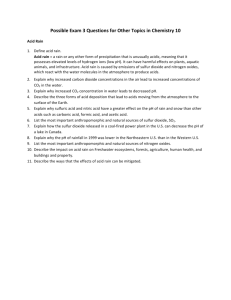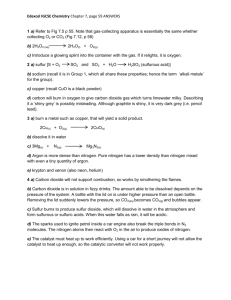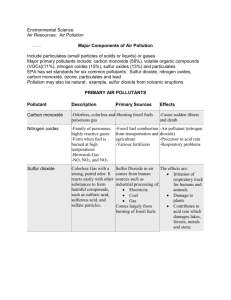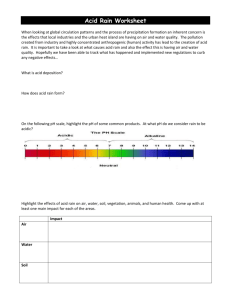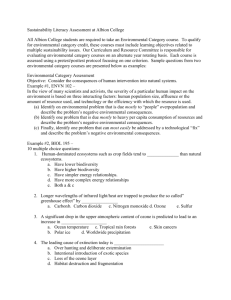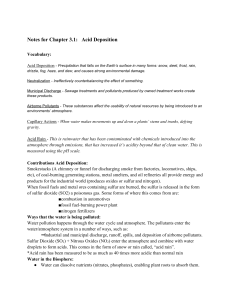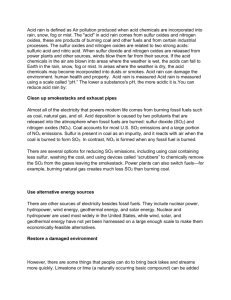File
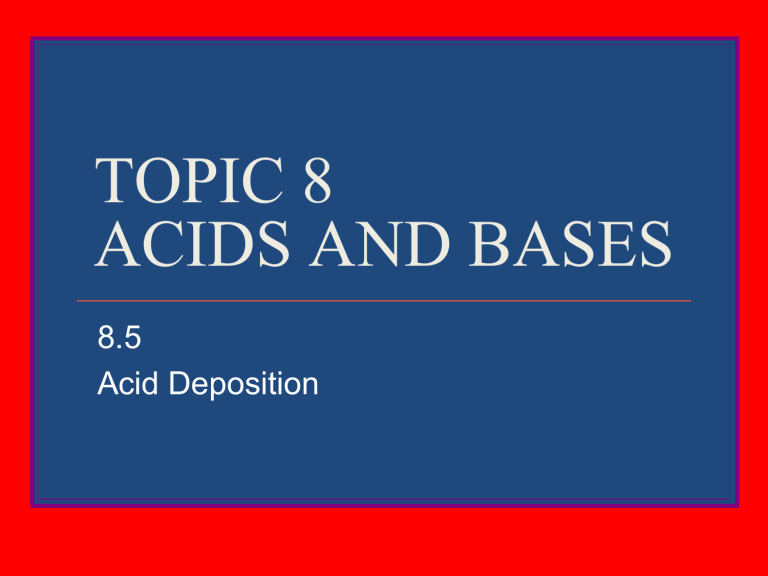
TOPIC 8
ACIDS AND BASES
8.5
Acid Deposition
ESSENTIAL IDEA
Increased industrialization has led to greater production of nitrogen and sulfur oxides leading to acid rain, which is damaging our environment.
These problems can be reduced through collaboration with national and intergovernmental organizations.
NATURE OF SCIENCE (4.8)
Risks and problems – oxides of metals and non-metals can be characterized by their acid-base properties. Acid deposition is a topic that can be discussed from different perspectives. Chemistry allows us to understand and to reduce the environmental impact of human activities.
INTERNATIONAL-MINDEDNESS
The polluter country and the polluted country are often not the same. Acid deposition is a secondary pollutant that affects regions far from the primary source. Solving this problem requires international cooperation.
THEORY OF KNOWLEDGE
All rain is acidic but not all rain is
“acid rain”. Scientific terms have a precise definition. Does scientific vocabulary communicate our knowledge in a neutral way or can it have value-laden terminology?
UNDERSTANDING/KEY IDEA
8.5.A
Rain is naturally acidic because of dissolved CO
2 and has a pH of
5.6. Acid deposition has a pH below 5.6.
All rain water is naturally acidic due to the presence of carbon dioxide which dissolves in water to produce carbonic acid, a weak acid.
The pH of rain water is 5.6.
H
2
O
(l)
+ CO
2(g)
→ H
2
CO
3(aq)
ACID RAIN
Acid rain refers to solutions with pH’s lower than 5.6, thus it must contain additional acids.
Acid rain is a secondary pollutant produced when the acidic gases of primary pollutants dissolve in water.
Oxides of sulfur and nitrogen are primary pollutants and are the main contributors of acid rain.
ACID DEPOSITION
Acid deposition is a broader term than acid rain and refers to all process by which acidic components as precipitates or gases leave the atmosphere and fall to earth.
Two types of acid deposition:
1. Wet deposition – rain, snow, sleet, hail, fog, mist and dew fall to the ground as aqueous precipitates.
2. Dry deposition – acidifying particles, gases fall to the ground as dust and smoke, later dissolving in water to form acids.
UNDERSTANDING/KEY IDEA
8.3.B
Acid deposition is formed when nitrogen or sulfur oxides dissolve in water to form HNO
3
, HNO
2
,
H
2
SO
4 and H
2
SO
3
.
The main active components of acid rain are the four acids HNO
3
, HNO
2
, H
2
SO
4 and H
2
SO
3
.
You are responsible for the reactions which produce these acids.
APPLICATIONS/SKILLS
Be able to balance equations that describe the combustion of sulfur and nitrogen to their oxides and the subsequent formation of
HNO
3
, HNO
2
, H
2
SO
4 and H
2
SO
3
.
SULFUR OXIDES
Sulfur dioxide is a colorless gas with a sharp smell. It dissolves in water to form sulfurous acid.
S
(s)
+ O
2(g)
→ SO
2(g)
SO
2(g)
+ H
2
O
(l)
→ H
2
SO
3(aq)
Sulfur dioxide can be oxidized to form sulfur trioxide which then dissolves in water to form sulfuric acid.
2SO
2(g)
+ O
2(g)
→ 2SO
3(g)
SO
3(g)
+ H
2
O
(l)
→ H
2
SO
4(aq)
The mechanisms can be complex in these reactions.
When water reacts with atomic oxygen or ozone, the hydroxyl radical can form ( .
OH).
.
.
OH + SO
2
→ .
OHSO
2
OHSO
2
+ O
2
→ .
HO
2
+ SO
3
NITROGEN OXIDES
Heat energy causes nitrogen and oxygen to combine to form nitrogen monoxide.
Nitrogen dioxide, a brown gas is formed by:
N
2(g)
1. N
2(g)
+ O
2(g)
2. 2NO
(g)
→ 2NO
(g)
+ 2O
2(g)
+ O
2(g)
→ 2NO
2(g)
→ 2NO
2(g)
Nitrogen dioxide dissolves in water to form a mixture of nitrous acid and nitric acid.
2NO
2(g)
+ H
2
O
(l)
→ HNO
2(aq)
+ HNO
3(aq)
Nitrogen dioxide can be oxidized to form nitric acid.
4NO
2(g)
+ 2H
2
O
(l)
+ O
2(g)
→ 4HNO
3(aq)
The mechanisms are also complex in these reactions.
Photo-oxidation, the presence of ozone and the hydroxyl radical can contribute to the production of nitrous and nitric acid.
.
OH + NO → HNO
2
.
OH + NO
2
→ HNO
3
UNDERSTANDING/KEY IDEA
8.3.C
Sources of the oxides of sulfur and nitrogen and the effects of acid deposition should be covered.
SOURCES OF THE ACIDIC
OXIDES
Sulfur dioxide is produced from the burning of fossil fuels particularly coal and heavy oil in power plants used to generate electricity.
It is also produced from metal smelting
(extracting metals from their ores).
50% of sulfur dioxide comes from coal.
Nitrogen monoxide is produced mainly from internal combustion engines.
EFFECTS OF ACID DEPOSITION
Impact on Materials
Marble and Limestone are forms of calcium carbonate.
Sulfur dioxide in dry deposition and sulfuric acid in acid rain react with CaCO
3 to form CaSO
4
.
Calcium sulfate is more soluble than calcium carbonate causing washout and it has a greater molar volume causing expansion and stress in the stonework.
A similar reaction with nitric acid forms a soluble nitrate salt causing washout.
APPLICATIONS/SKILLS
Be able to deduce acid deposition equations for acid deposition with reactive metals and carbonates.
Acid deposition also affects metals, causing corrosion.
Components of both dry deposition and acid rain react with metals such as iron to form a metallic salt.
The metallic salt enables ionic conductivity which leads to higher electrochemical corrosion.
Acid rain also reacts with and removes the protective oxide layer on metals which can cause significant damage to metallic structures such as bridges and vehicles.
CARBONATE REACTIONS
These reactions lead to erosion of structures, historic buildings and statues.
2CaCO
3(s)
CaCO
3(s)
+ 2SO
2(g)
+ H
2
SO
4(aq)
+ O
2(g)
→ 2CaSO
4(aq)
→ CaSO
4(aq)
+ H
2
O
(l)
+ 2CO
2(g)
+ CO
2(g)
CaCO
3(s)
+ 2HNO
3(aq)
→ Ca(NO
3
)
2(aq)
+ H
2
O
(l)
+ CO
2(g)
METAL REACTIONS
Fe
(s)
Fe
(s)
+ SO
+ H
2
2(g)
SO
+ O
2(g)
4(aq)
→ FeSO
4(aq)
→ FeSO
4(aq)
+ H
2 (g)
Al
2
O
3(s)
+ 6HNO
3(aq)
→ Al(NO
3
)
3(aq)
+ 3H
2
O
(l)
MORE EFFECTS OF ACID
DEPOSITION
Impact on plant life
Acid rain causes damage to plant life.
It leaches away the minerals Mg 2+ , Ca 2+ and K + before they can be absorbed by plants.
It releases ions such as Al 3+ which is toxic to plants damaging plant roots.
Dry deposition blocks the pores for gas exchange in plants.
Impact on water
Acid rain has caused numerous lakes to become
“dead”.
Many fish cannot survive below pH’s below 5.
Toxic Al 3+ ions leach out at pH’s below 4 which interferes with the operation of the gills of fish.
It also causes eutrophication caused by the nitrates in acid rain. This over-fertilization results in algae blooms leading to oxygen depletion.
Impact on Human Health
Acid rain does not directly affect human health.
However, it’s components react to form fine sulfate and nitrate particles that can travel long distances and can be inhaled.
These particles irritate the respiratory tract and increase the risk of asthma, bronchitis and emphysema.
Released heavy metal ions can also pose a health risk.
APPLICATIONS/SKILLS
Be able to distinguish between the pre-combustion and postcombustion methods of reducing sulfur oxides emissions.
REDUCTION OF SO
2
EMISSIONS
Pre-combustion methods
Processes which reduce or remove sulfur in coal or oil before combustion.
Metal sulfides can be removed by crushing and washing.
Hydrodesulfurization (HDS) – reacts sulfur to form H
2
S which is captured and later used to produce sulfuric acid.
REDUCTION OF SO
2
EMISSIONS
Post-combustion methods
Flue-gas desulfurization – removes up to 90% of
SO
2 from flue gas before it reaches the atmosphere.
REDUCTION OF NO
x
EMISSIONS
Catalytic converters in vehicles
Process by which the catalytic converter installed on cars converts toxic emissions into relatively harmless products such as carbon dioxide and hydrogen.
Lower temperature combustion
Recirculate exhaust gases back into the engine which lowers the temperature and reduces the nitrogen monoxide in the emissions.
Citations
International Baccalaureate Organization. Chemistry Guide, First assessment 2016. Updated 2015.
Brown, Catrin, and Mike Ford.
Higher Level Chemistry . 2nd ed.
N.p.: Pearson Baccalaureate, 2014. Print.
Most of the information found in this power point comes directly from this textbook.
The power point has been made to directly complement the Higher
Level Chemistry textbook by Catrin and Brown and is used for direct instructional purposes only.

